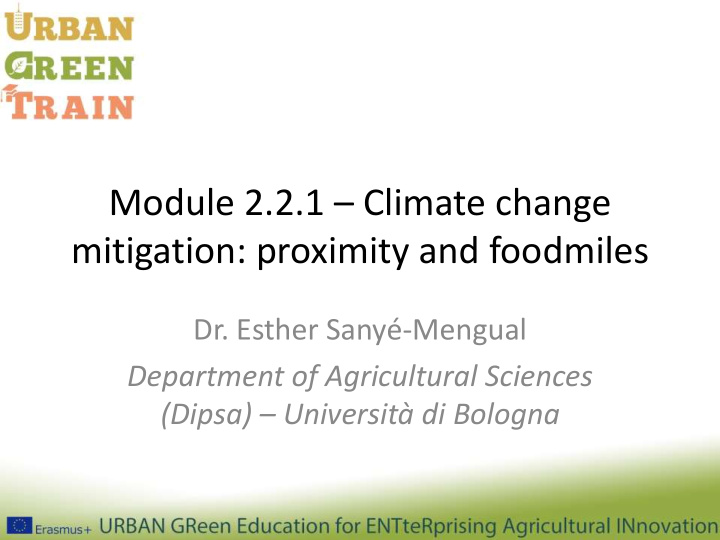



Module 2.2.1 – Climate change mitigation: proximity and foodmiles Dr. Esther Sanyé-Mengual Department of Agricultural Sciences (Dipsa) – Università di Bologna
European greenhouse gas emissions, by sector Source: Barilla Center for Food and Nutrition
Agriculture contribution to climate change Land use change Resources Fertilizers Fuel Food loss (Forest to consumption application consumption and waste crop)
Climate change impacts on agriculture Source: Ministry of the Environment, Government of Japan
Climate change impacts on agriculture Source: CGIAR Annual report
Food chain impacts Source: Barilla Center for Food and Nutrition
Food-miles concept Food-miles accounts for the distance that food is transported between producer and consumer “how far food travels en route to your stomach.” (Schnell, 2013) ‘‘Hundred - mile diet’’ a challenge to get people to eat as much as possible from within 100 miles of their home (Smith and MacKinnon 2007). Schnell, Steven M. "Food miles, local eating, and community supported agriculture: putting local food in its place." Agriculture and Human Values 30.4 (2013): 615-628. Smith, A., and J.B. MacKinnon. 2007. Plenty: Eating locally on the 100-mile diet (originally published as The 100-mile diet: A year of eating locally (in Canada) and as Plenty: One man, one woman, and a raucous year of eating locally (in the U.S.)). New York: Three Rivers Press.
Local production Cities have displaced farmland during urban development periods, leading to increased food imports to satisfy food demand
Local production Local food systems, such as urban agriculture, aims to recover farmland spaces or create new ones to increase local food production and shorten the distance between producers and consumers Environmental awareness Local consumers Urban agriculture Sustainable cities
Local production Environmental benefits of local supply-chains Transport requirements DISTANCE Packaging use Food waste Sanyé‐Mengual et al. "Environmental analysis of the logistics of agricultural products from roof top greenhouses in Mediterranean urban areas."Journal of the Science of Food and Agriculture 93.1 (2013): 100-109.
Case studies
Blanke and Burdick (2005) Comparison of apple production in Germany (supply chain: 200km) and imported apples from New Zealand (Supply-chain: 23.400km)
Blanke and Burdick (2005)
Jones (2002) Homegrown and local apples had a lower climate change impact than imported apples
Payen (2015) Limitations of climate change as single indicator: Payen (2015) highlighted the potential trade-offs between climate change and water deprivation when comparing tomatoes from Morocco and from France.
References • Blanke, Michael, and Bernhard Burdick. "Food (miles) for thought-energy balance for locally-grown versus imported apple fruit (3 pp)." Environmental Science and Pollution Research 12.3 (2005): 125-127. • Jones, Andy. "An environmental assessment of food supply chains: a case study on dessert apples." Environmental management 30.4 (2002): 560-576. • Payen, Sandra, Claudine Basset-Mens, and Sylvain Perret. "LCA of local and imported tomato: an energy and water trade-off." Journal of Cleaner Production 87 (2015): 139-148.
Module 2.2.1 – Climate change mitigation: proximity and foodmiles Dr. Esther Sanyé-Mengual Department of Agricultural Sciences (Dipsa) – Università di Bologna
Recommend
More recommend